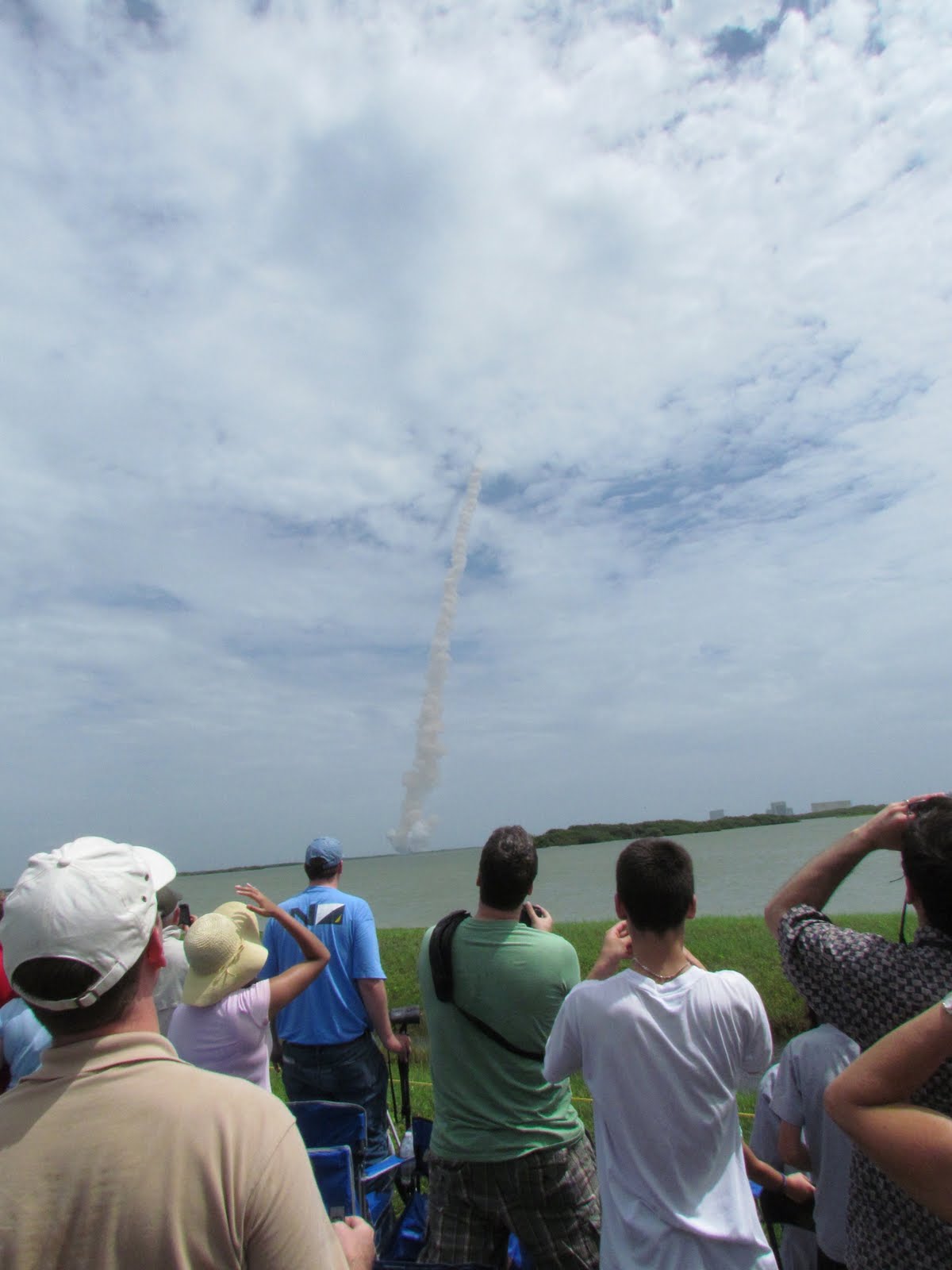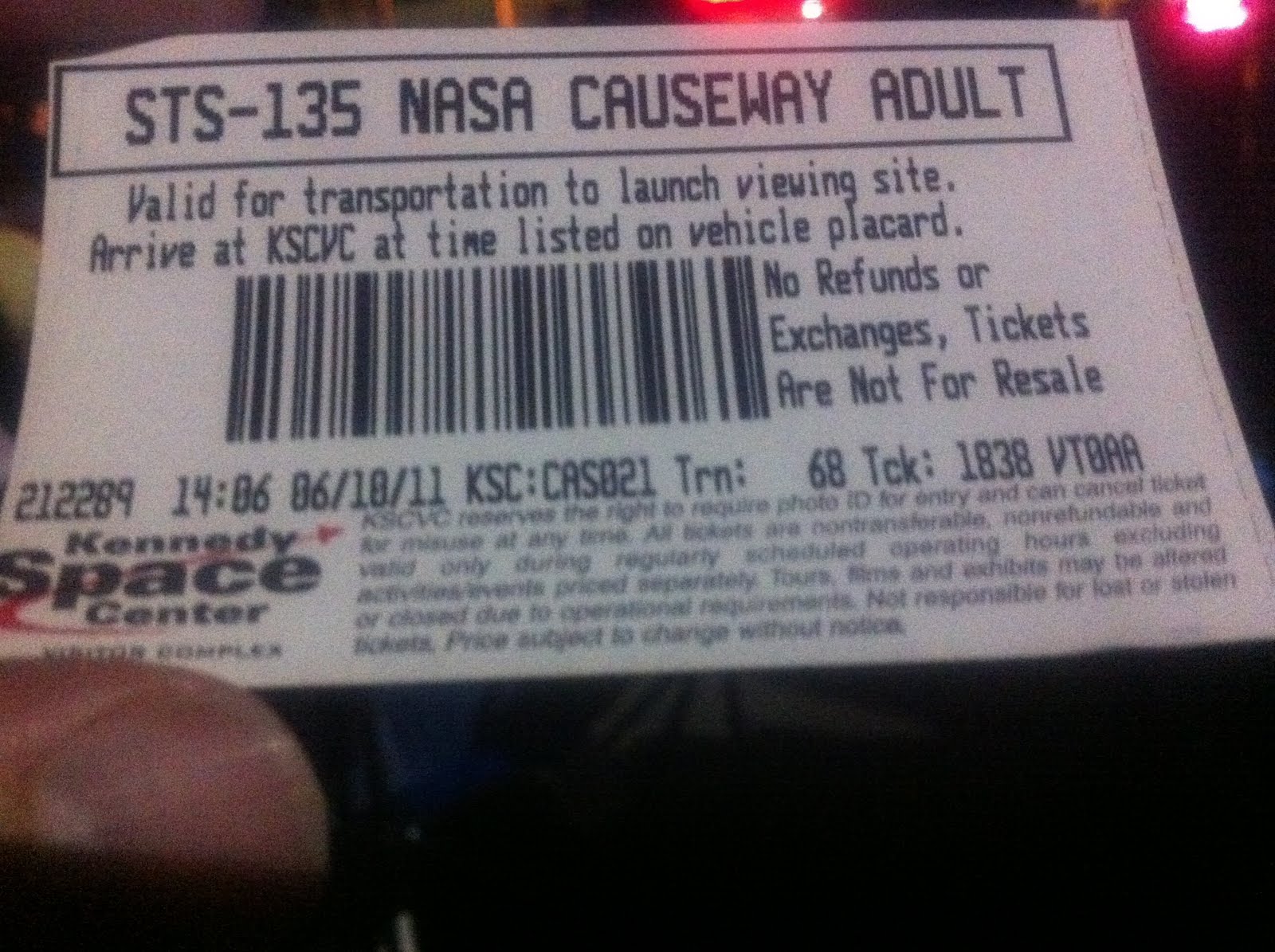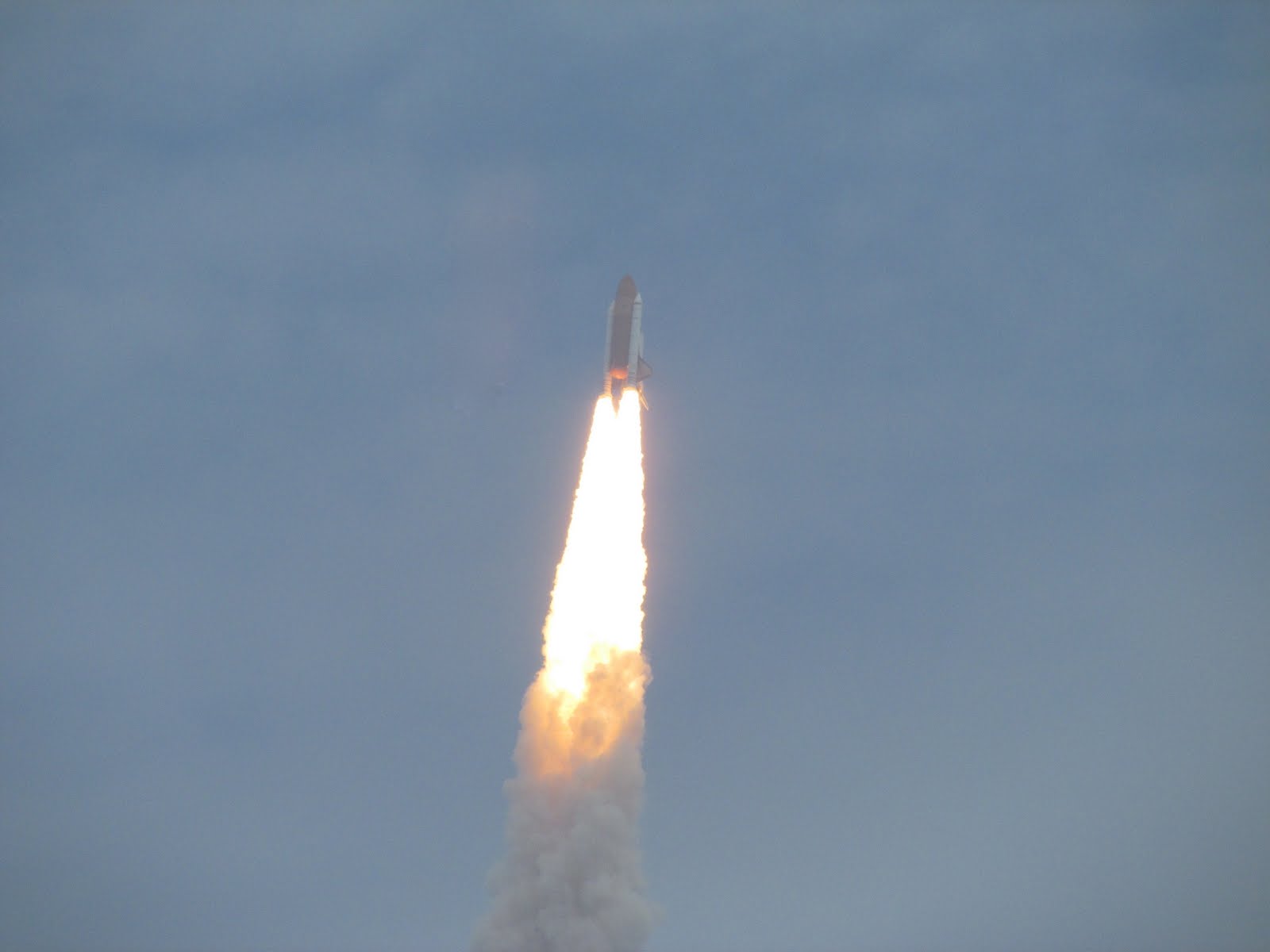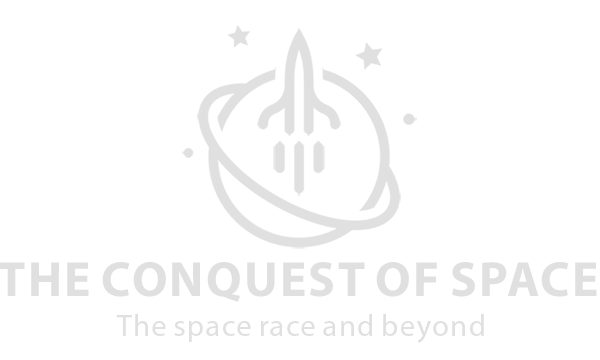Watching the End of the Space Shuttle Era
It was estimated that between 750,000 and 1,000,000 people were at the Space Coast to catch a fading  glimpse of American history. They crowded parks and straddled roadsides jamming into any available space that offered a line of sight to the last launch of the Space Shuttle Program. Several thousand of those onlookers were lucky enough to win the Kennedy Space Center Ticket lottery, others purchased VIP packages from tour vendors, a very lucky few were selected by NASA to attend as guest tweeters and report live via Twitter from the launch. I purchased my ticket on the open market having failed to secure one by another means. The final launch of the Shuttle as it turns out was a hot commodity and that was not unexpected.
glimpse of American history. They crowded parks and straddled roadsides jamming into any available space that offered a line of sight to the last launch of the Space Shuttle Program. Several thousand of those onlookers were lucky enough to win the Kennedy Space Center Ticket lottery, others purchased VIP packages from tour vendors, a very lucky few were selected by NASA to attend as guest tweeters and report live via Twitter from the launch. I purchased my ticket on the open market having failed to secure one by another means. The final launch of the Shuttle as it turns out was a hot commodity and that was not unexpected.
Many Shuttle ticket lottery winners saw this as an opportunity to make a fast buck. Simply buy a ticket (up to six) for $75 each and sell for $1500 each to those that wanted to be there to experience the last launch. As soon as email notices went out tickets appeared for sale online through ticket brokers. It was too fast for this to be anything other than an orchestrated way that the system had been beat. Those that wanted to go had been outdone by professionals who leveraged technology to gain an advantage, but such is the American way. The lure of making money often drives creativity and innovation.
 I was watching as ticket prices of early online auctions soared into the thousands. Caught in the frenzy, I bid, only to be outbid. I bid more than I planned and thought reasonable and still was outbid. The last flight of the Shuttle would not escape enterprising individuals who could make a profit and those loyal space followers who would pay any price to be there.
I was watching as ticket prices of early online auctions soared into the thousands. Caught in the frenzy, I bid, only to be outbid. I bid more than I planned and thought reasonable and still was outbid. The last flight of the Shuttle would not escape enterprising individuals who could make a profit and those loyal space followers who would pay any price to be there.
For this occasion I was determined to see the launch, but much like the Shuttle the economics were not making sense, even for a true follower. Spaceflight was never inexpensive and as it turns out watching a spaceflight would become nearly as costly. Finally, I caught a break on an afternoon auction that was expiring right before 5pm. Activity had seemed somewhat low that day and it looked like I might have a chance. I ended up getting two tickets for about 8x the going rate. A bargain compared to other tickets that had gone before and after me at an average of 20x the face value, but standing out on the NASA Causeway as Atlantis lifted off for the final time would be priceless. This could not be the launch I would miss. Recently, I had heard someone say that buying “things” is not as important as buying “experiences”. Things wear out, get tossed away or replaced over time, but experiences never fade from our memories. They are permanent and evoke emotions that transport us to a time and place where doing something mattered much more than having something. So it was with the Shuttle, being there to see it meant everything.
That experience went beyond the 45 seconds or so it took the Shuttle to go  from the launch pad to the clouds and out of sight for those of us looking up from below. It started with a sleepless Thursday night. A few rearranged meetings led to a short workday and it was off to the airport to catch a flight to Orlando. From there we caught dinner and made our way to the vicinity of the Space Center. At 11PM Thursday night the Space Center was not yet open to vehicles with passes. A nearby shopping center in Titusville became a temporary camping ground as many parked their cars to nap for just a few hours. It was late into the night and realistically it would be another 15 or more hours before we would be at the hotel to catch-up on sleep. An adrenaline rush was sustaining us. Sleeping, even for just an hour seemed hopeless. At about 2AM I drove back the Space Center and found that it had opened to visitors. The crowds were trickling in and the parking lot had fewer cars than I expected. Most ticket holders were told to be there by 4AM and we were running ahead of the thousands expected to soon be at the complex.
from the launch pad to the clouds and out of sight for those of us looking up from below. It started with a sleepless Thursday night. A few rearranged meetings led to a short workday and it was off to the airport to catch a flight to Orlando. From there we caught dinner and made our way to the vicinity of the Space Center. At 11PM Thursday night the Space Center was not yet open to vehicles with passes. A nearby shopping center in Titusville became a temporary camping ground as many parked their cars to nap for just a few hours. It was late into the night and realistically it would be another 15 or more hours before we would be at the hotel to catch-up on sleep. An adrenaline rush was sustaining us. Sleeping, even for just an hour seemed hopeless. At about 2AM I drove back the Space Center and found that it had opened to visitors. The crowds were trickling in and the parking lot had fewer cars than I expected. Most ticket holders were told to be there by 4AM and we were running ahead of the thousands expected to soon be at the complex.
The lines to get through security were surprisingly short. Previous launches I attended had very long lines that stretched from the entrance of the center all the way to the back parking lot. The price of passing on sleep was rewarded by short lines and getting one step closer to history. The atmosphere around the Visitor Center was friendly as one big family of space fans gathered one last time to share a common passion. The main plaza would soon become a sea of people covering every available spot of concrete where a chair or two feet could rest. The Space Shop was jammed with those buying up “Made in China” toys and mementoes of the last launch. An irony that while our leaders seem hesitant to fund our space program, our appetite for cheap goods made abroad was funding ambitious space programs in China and India. If everyone in America had the same passion as those buying souvenirs inside the store, we would forever stand unchallenged in human spaceflight. Many, like me, will go back to their homes and offices and place replica Space Shuttles on their desks and shelves as a reminder of what we once accomplished and with no clear path of where we were going.
Here in America, we tend to cherish “firsts” and not “lasts”. The first time we do something it is an accomplishment. It means the best is still ahead of us. The last time we do something it usually means the best is behind us. Those that went to Florida to see the last flight of Atlantis are the breed that has a passion for space, a desire to see what America can accomplish, but they also know our country. They came to view something that we may never see again in our lifetime – humans flying into space and gliding back to Earth. We almost certainly will not see the likes of a spacecraft like the Shuttle again, but NASA will continue to search for ways to do the impossible on shoestring budgets. History has taught us that it cannot be done. The real lesson of the Space Shuttle is that money does matter. Since Richard Nixon, money is all that has mattered when it came to human spaceflight. The downturn in the economy and the fiscal woes our nation faces are just the latest excuse for why sending humans into space is a low priority.
The hard and simple truth is that we do not want to do this in a way that is right and sustainable because it might cost too much. While Nixon started us down this path, there were many along the way that kept the space program at bay. Presidents and Congress squabbled over investing in manned space; NASA itself had a hand in this by showing that it was not infallible in the post-Apollo era. Strategy and operational missteps showed an already skeptical Congress that the only way to ensure a NASA program met its budget was to not build it. Money to spend is only a problem when we want it to be. In 2010 and 2011 the United States doled out foreign aid to China, Russia, Brazil, India, Mexico, and Egypt to name a few. Some of those countries are awash in surplus trade dollars from Americans buying their cars, goods, resources, toys, and services. Yes, you read that right. We are generous in this country. We have given, and wasted our precious national treasure until it has become painful. We find billions to fight endless wars around the globe, but if there were no war, the dollars to keep the dreams of space alive would be just as scarce. Not having a follow-up ready for the Space Shuttle is not a national tragedy; it’s a leadership and imagination failure. One we cannot seem to learn. It is also a question of heart, of having the will to explore, be curious, and stare down impossible challenges until we conquer them. Why is it that we seemed destined for creating mediocrity when greatness is our heritage?
 At 11:36AM on Friday, July 8th, I stood as a witness to history being made. I had made it to the last Space Shuttle flight. The Shuttle beat the odds one more time and despite clouds and with only a 30% chance of launch it thundered into the Florida sky on-time. It was a bittersweet moment that has yet to sink in. I had made my mind up long ago that I would be there for the end of the Shuttle program. I had been to four launches and two landings over the program’s history, far too few for someone that cherished the thought of one day making it into space. The end of a space program was something I had seen before. Throughout the sixties I watched America’s march to the moon. The thrill of the space race left me wanting more. Moon bases and footprints on Mars were just around the corner. Ten years after Apollo 11 we were supposed to be standing on Mars, but when 1980 came we had already been stuck on the ground for years. When the Apollo program disappeared it left me at a crossroads stuck at which direction to go –follow an uncertain dream or take the well worn path. Today, young Americans will be faced with the same choice and many will not wait for the space program to regain its swagger. The past forty years have shown us that once we let our momentum go, no matter how big or small it is, it is tough to get it back. When Atlantis soared into space for the last time it carried with the dreams of many young minds, minds that will see reaching the stars as not their dreams, but as those belonging to writers who will spin fictional tales of what should have been.
At 11:36AM on Friday, July 8th, I stood as a witness to history being made. I had made it to the last Space Shuttle flight. The Shuttle beat the odds one more time and despite clouds and with only a 30% chance of launch it thundered into the Florida sky on-time. It was a bittersweet moment that has yet to sink in. I had made my mind up long ago that I would be there for the end of the Shuttle program. I had been to four launches and two landings over the program’s history, far too few for someone that cherished the thought of one day making it into space. The end of a space program was something I had seen before. Throughout the sixties I watched America’s march to the moon. The thrill of the space race left me wanting more. Moon bases and footprints on Mars were just around the corner. Ten years after Apollo 11 we were supposed to be standing on Mars, but when 1980 came we had already been stuck on the ground for years. When the Apollo program disappeared it left me at a crossroads stuck at which direction to go –follow an uncertain dream or take the well worn path. Today, young Americans will be faced with the same choice and many will not wait for the space program to regain its swagger. The past forty years have shown us that once we let our momentum go, no matter how big or small it is, it is tough to get it back. When Atlantis soared into space for the last time it carried with the dreams of many young minds, minds that will see reaching the stars as not their dreams, but as those belonging to writers who will spin fictional tales of what should have been.
The retirement of the Space Shuttle has caused many to reflect and write about the program. Forty years of Shuttle history dating back to the late sixties and early seventies is being revisited to analyze what story should be told about the vehicle’s place in the legacy of human spaceflight. Looking back, the reviews and the feelings will be mixed. One could easily argue that the system itself served us well for thirty years and that its human caretakers failed in more ways than the technology. There is little disputing that the economics of the Space Shuttle never worked out as planned. They often do not when breaking Earth’s gravity with gigantic and complex machines are required. The Space Transportation System had fallen victim to America’s love affair with creating multipurpose Swiss Army knife vehicles. It was surmised that building two specialty vehicles that did 100% of their role effective and efficiently wasn’t as cost effective as one vehicle could do 50% of each role, but do neither effectively or efficiently. That math quickly caught up with the Shuttle and soon safely managing the most complex machine ever built by humans would also.
With the technology odds stacked attacked against it and the compromises  made to get over political and budget hurdles , the Shuttle itself performed remarkably well. It was expensive, but NASA quickly adapted to repeatedly operating in low Earth orbit. However, common sense gave way to complacency as twice the system failed at the hands of its human managers. Those responsible for the program became overconfident and believed that spaceflight had become routine. The history of the Shuttle is littered with other close calls where potential disaster was a shadow that hung over each flight whether the public knew it or not. The loss of one vehicle and her crew was a tragedy; the loss of a second became a disaster for the program and human spaceflight. The Shuttle was a vehicle that could never be made safe, but after thirty years of trial and costly errors we had just learned to make it safer. Just in time to abandon the program and learn the lessons of a new vehicle all over again.
made to get over political and budget hurdles , the Shuttle itself performed remarkably well. It was expensive, but NASA quickly adapted to repeatedly operating in low Earth orbit. However, common sense gave way to complacency as twice the system failed at the hands of its human managers. Those responsible for the program became overconfident and believed that spaceflight had become routine. The history of the Shuttle is littered with other close calls where potential disaster was a shadow that hung over each flight whether the public knew it or not. The loss of one vehicle and her crew was a tragedy; the loss of a second became a disaster for the program and human spaceflight. The Shuttle was a vehicle that could never be made safe, but after thirty years of trial and costly errors we had just learned to make it safer. Just in time to abandon the program and learn the lessons of a new vehicle all over again.
We can only hope that companies like SpaceX and Orbital Sciences can deliver on their goal to relieve NASA of reaching low-Earth orbit so that it can focus on deeper space. However, with the recent announcement that the Webb telescope might fall victim to cancellation, money has come again to the forefront of the space program. It might be that we will be circling planet Earth for a long time as our leaders hearts and checkbooks remain as far away as the goal of putting humans on Mars. I thought I would see in my lifetime humans walk again on the moon, then on Mars, but each time and with each new vision the day that goal will be realized is something my children or grandchildren might see. I hope that as some have speculated that we will not wait until China or India touches down on the lunar surface and folds the flag of Apollo 11 as a souvenir that we are spurred to action. The time to plan our next steps in space have long passed. From here we will be playing catch-up to countries that see space as a means to spur technological advancement. Those countries see now what we once saw in ourselves.

What an awesome recap of your experience. I bought my children a similar experience on STS-132.
Commercial Crew has the potential to carry on the legacy of shuttle… if congress allows it.
Respectfully,
Andrew Gasser
TEA Party in Space